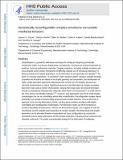| dc.contributor.author | Zarzar, Lauren D. | |
| dc.contributor.author | Sresht, Vishnu | |
| dc.contributor.author | Sletten, Ellen M. | |
| dc.contributor.author | Blankschtein, Daniel | |
| dc.contributor.author | Kalow, Julia Ann | |
| dc.contributor.author | Swager, Timothy M | |
| dc.date.accessioned | 2016-02-09T20:24:02Z | |
| dc.date.available | 2016-02-09T20:24:02Z | |
| dc.date.issued | 2015-02 | |
| dc.date.submitted | 2014-10 | |
| dc.identifier.issn | 0028-0836 | |
| dc.identifier.issn | 1476-4687 | |
| dc.identifier.uri | http://hdl.handle.net/1721.1/101147 | |
| dc.description.abstract | Emulsification is a powerful, well-known technique for mixing and dispersing immiscible components within a continuous liquid phase. Consequently, emulsions are central components of medicine, food and performance materials. Complex emulsions, including Janus droplets (that is, droplets with faces of differing chemistries) and multiple emulsions, are of increasing importance in pharmaceuticals and medical diagnostics, in the fabrication of microparticles and capsules for food, in chemical separations, in cosmetics, and in dynamic optics. Because complex emulsion properties and functions are related to the droplet geometry and composition, the development of rapid, simple fabrication approaches allowing precise control over the droplets’ physical and chemical characteristics is critical. Significant advances in the fabrication of complex emulsions have been made using a number of procedures, ranging from large-scale, less precise techniques that give compositional heterogeneity using high-shear mixers and membranes, to small-volume but more precise microfluidic methods. However, such approaches have yet to create droplet morphologies that can be controllably altered after emulsification. Reconfigurable complex liquids potentially have great utility as dynamically tunable materials. Here we describe an approach to the one-step fabrication of three- and four-phase complex emulsions with highly controllable and reconfigurable morphologies. The fabrication makes use of the temperature-sensitive miscibility of hydrocarbon, silicone and fluorocarbon liquids, and is applied to both the microfluidic and the scalable batch production of complex droplets. We demonstrate that droplet geometries can be alternated between encapsulated and Janus configurations by varying the interfacial tensions using hydrocarbon and fluorinated surfactants including stimuli-responsive and cleavable surfactants. This yields a generalizable strategy for the fabrication of multiphase emulsions with controllably reconfigurable morphologies and the potential to create a wide range of responsive materials. | en_US |
| dc.description.sponsorship | Eni S.p.A. (Firm) (Eni-MIT Alliance Solar Frontiers Program) | en_US |
| dc.description.sponsorship | Massachusetts Institute of Technology. Institute for Soldier Nanotechnologies (Contract W911NF-13-D-0001) | en_US |
| dc.description.sponsorship | National Institutes of Health (U.S.). Ruth L. Kirschstein National Research Service Fellowship (EB014682) | en_US |
| dc.description.sponsorship | National Institutes of Health (U.S.). Ruth L. Kirschstein National Research Service Fellowship (GM106550) | en_US |
| dc.language.iso | en_US | |
| dc.publisher | Nature Publishing Group | en_US |
| dc.relation.isversionof | http://dx.doi.org/10.1038/nature14168 | en_US |
| dc.rights | Creative Commons Attribution-Noncommercial-Share Alike | en_US |
| dc.rights.uri | http://creativecommons.org/licenses/by-nc-sa/4.0/ | en_US |
| dc.source | PMC | en_US |
| dc.title | Dynamically reconfigurable complex emulsions via tunable interfacial tensions | en_US |
| dc.type | Article | en_US |
| dc.identifier.citation | Zarzar, Lauren D., Vishnu Sresht, Ellen M. Sletten, Julia A. Kalow, Daniel Blankschtein, and Timothy M. Swager. “Dynamically Reconfigurable Complex Emulsions via Tunable Interfacial Tensions.” Nature 518, no. 7540 (February 25, 2015): 520–24. | en_US |
| dc.contributor.department | Massachusetts Institute of Technology. Institute for Soldier Nanotechnologies | en_US |
| dc.contributor.department | Massachusetts Institute of Technology. Department of Chemical Engineering | en_US |
| dc.contributor.department | Massachusetts Institute of Technology. Department of Chemistry | en_US |
| dc.contributor.mitauthor | Zarzar, Lauren D. | en_US |
| dc.contributor.mitauthor | Sletten, Ellen M. | en_US |
| dc.contributor.mitauthor | Kalow, Julia Ann | en_US |
| dc.contributor.mitauthor | Swager, Timothy Manning | en_US |
| dc.contributor.mitauthor | Sresht, Vishnu | en_US |
| dc.contributor.mitauthor | Blankschtein, Daniel | en_US |
| dc.relation.journal | Nature | en_US |
| dc.eprint.version | Author's final manuscript | en_US |
| dc.type.uri | http://purl.org/eprint/type/JournalArticle | en_US |
| eprint.status | http://purl.org/eprint/status/PeerReviewed | en_US |
| dspace.orderedauthors | Zarzar, Lauren D.; Sresht, Vishnu; Sletten, Ellen M.; Kalow, Julia A.; Blankschtein, Daniel; Swager, Timothy M. | en_US |
| dc.identifier.orcid | https://orcid.org/0000-0002-5764-9383 | |
| dc.identifier.orcid | https://orcid.org/0000-0002-4449-9566 | |
| dc.identifier.orcid | https://orcid.org/0000-0002-3287-3602 | |
| dc.identifier.orcid | https://orcid.org/0000-0002-7836-415X | |
| mit.license | OPEN_ACCESS_POLICY | en_US |

